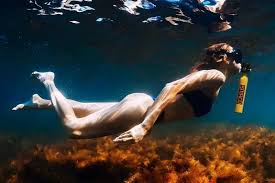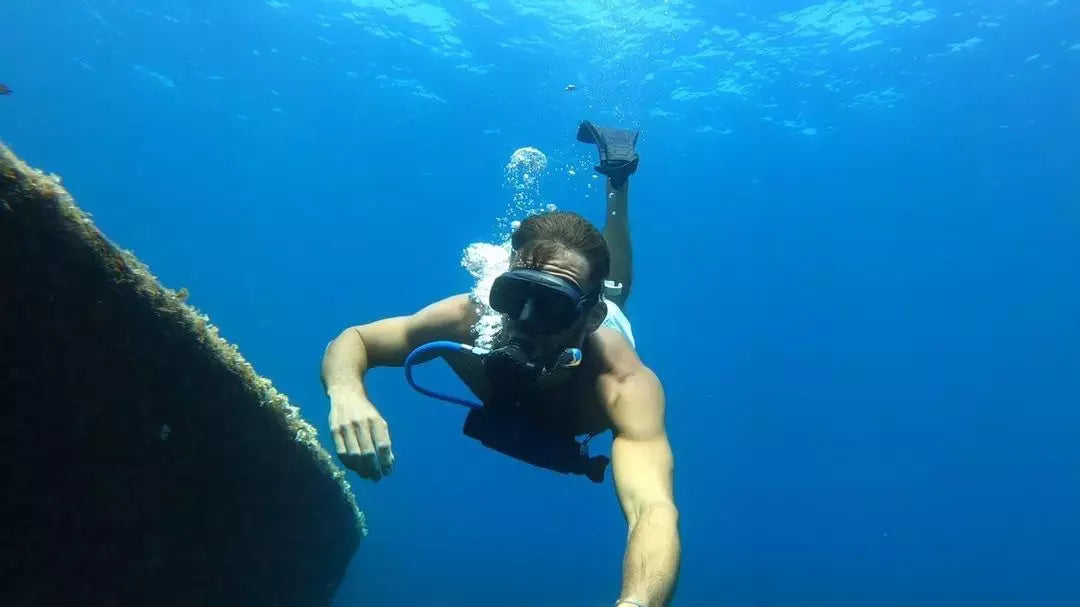A 1L mini scuba tank lasts 5–7 minutes at 10m (33ft) with moderate breathing, 3–5 minutes at 20m (66ft) due to increased pressure, and 1–2 minutes at 30m (98ft) as air consumption spikes. Deeper dives reduce duration sharply because each breath uses more compressed air. Always monitor your gauge and ascend safely.
Tank Basics Explained
These tanks are typically made of aluminum or carbon fiber, weighing between 1.5–3 kg when empty. The air capacity is 1 liter at 200–300 bar pressure, which translates to roughly 200–300 liters of breathable air when released at surface pressure. Unlike larger scuba tanks (8–12L), mini tanks are not designed for extended dives but rather for quick underwater excursions or as a safety measure.
The working pressure (the amount of air actually usable before reaching reserve levels) is around 80% of the tank’s rated capacity, meaning a 200-bar tank effectively provides 160 bar of usable air. At shallow depths, this can last 5–10 minutes, but deeper dives drastically reduce dive time due to increased air density and consumption rates.
Key Factors Affecting Air Consumption
-
Depth – Air consumption increases with depth because each breath draws more compressed air. At 10m (2 ATM pressure), you use twice the air per breath compared to the surface.
-
Breathing Rate – A relaxed diver consumes 15–20 liters per minute (LPM), while an active or stressed diver can exceed 30 LPM.
-
Tank Efficiency – Not all air is accessible; 10–20% remains unused due to regulator cutoff and safety margins.
Comparison of Mini vs. Standard Scuba Tanks
|
Feature |
1L Mini Tank |
Standard 12L Tank |
|---|---|---|
|
Air Volume |
200–300L |
2400–3000L |
|
Weight (Full) |
2–4 kg |
15–20 kg |
|
Dive Time (10m) |
5–10 min |
45–60 min |
|
Best Use Case |
Snorkeling, short dives |
Recreational diving |
Mini tanks are not a replacement for full-sized scuba gear but serve well for quick underwater photography, shallow exploration, or emergency backup.
Real-World Usage Example
A 1L tank filled to 200 bar contains 200L of air. If a diver breathes at 20 LPM at 10m depth, the tank lasts 5 minutes (200L ÷ 40LPM, accounting for doubled consumption at depth). At 20m (3 ATM), the same tank lasts only 2–3 minutes because each breath now uses three times the air.
For those considering a mini tank, monitoring air supply closely is critical since depletion happens rapidly.
10m Depth: Air Usage
At 10 meters (33 feet), a 1L mini scuba tank provides 5–7 minutes of air for an average diver breathing at a moderate rate of 20 liters per minute (LPM). This depth doubles the ambient pressure compared to the surface (2 ATM), meaning each breath consumes twice the volume of air stored in the tank. For example, a single inhalation that would normally use 1 liter at the surface now requires 2 liters at 10m.
A standard 200-bar 1L tank holds 200 liters of air when decompressed to surface pressure. However, due to depth-induced air density, only about 80% (160 liters) is practically usable before reaching reserve levels. If a diver breathes at 20 LPM, the adjusted consumption rate at 10m becomes 40 LPM (20 x 2 for pressure). This means the tank lasts 4 minutes at a steady breathing rate (160L ÷ 40LPM). In real-world conditions, slight variations in breathing efficiency, movement, and stress can extend or reduce this time by 1–3 minutes.
Factors That Influence Air Duration at 10m
-
Breathing Control – Experienced divers using slow, deep breaths can reduce consumption to 15 LPM, stretching dive time to 6–7 minutes.
-
Activity Level – Swimming against currents or rapid finning increases demand to 25–30 LPM, cutting dive time to 3–4 minutes.
-
Tank Pressure – A 300-bar fill provides 50% more air (300L usable) than a 200-bar fill, extending dive time to 7–10 minutes under ideal conditions.
For recreational diving beyond 10 minutes, a standard 12L tank is a far more reliable choice. However, for short explorations, underwater photography, or emergency backup, a 1L tank performs adequately if monitored carefully.

20m Depth: Time Drop
At 20 meters (66 feet), a 1L mini scuba tank’s air supply disappears alarmingly fast—lasting just 2–4 minutes for most divers. The physics are unforgiving: every breath at this depth pulls three times more air than at the surface due to the 3 ATM pressure. That calm surface breath consuming 1 liter suddenly demands 3 liters from your tank, draining it in minutes.
If you breathe at an average rate of 20 LPM on land, your adjusted consumption at 20m skyrockets to 60 LPM. Simple math reveals the problem: 160L ÷ 60LPM = 2.6 minutes of dive time under ideal conditions. In reality, stress, movement, or equipment inefficiencies often slash that to under 2 minutes.
A perfectly relaxed diver (15 LPM) might stretch their air to 3–4 minutes, while an anxious or active diver (30 LPM) could gasp through their entire supply in 90 seconds. Cold water amplifies the issue, triggering involuntary hyperventilation that increases consumption by 30–50%. Even a 300-bar fill—offering 50% more air—only buys an extra minute or two before the tank hits reserve levels.
Delivering air against 3 ATM water pressure requires more effort, slightly reducing delivery efficiency compared to shallow dives. Meanwhile, the psychological weight of knowing your air is vanishing faster than your dive computer can refresh the display often leads to self-fulfilling panic breathing.
Compared to a standard 12L tank (which provides 30–40 minutes at 20m), the 1L mini tank’s 2–4 minute window leaves no room for error. An out-of-air emergency at this depth is exponentially more dangerous than at 10m due to longer ascent times and mandatory safety stops. Buddy rescues become nearly impossible if both divers rely on mini tanks.
Practical takeaways for divers:
-
Treat a 1L tank at 20m as an absolute last-resort air source, not a primary system.
-
Begin ascending at 50 bar—hesitation risks lethal air starvation during ascent.
-
Avoid any activity that increases breathing rate; even mild finning can halve your remaining time.
While these tanks work for brief, hyper-controlled descents, their razor-thin safety margin makes them unsuitable for recreational diving at 20m. For anything beyond a quick down-and-up, a proper 12L tank isn’t just smarter—it’s the only responsible choice.
30m Depth: Rapid Drain
At 30 meters (98 feet), a 1L mini scuba tank becomes dangerously fleeting—lasting a mere 60–120 seconds for most divers. The crushing 4 ATM pressure at this depth quadruples air consumption compared to the surface. What would be a single 1-liter breath topside now guzzles 4 liters from your tank. Even with perfect breathing discipline, the math is brutal: a 200-bar tank’s 160L of usable air disappears in 40 seconds per breath if you’re consuming 20 LPM on land (which becomes 80 LPM at depth).
The moment you hit 30m, three factors conspire to drain your tank faster than you can track:
-
Pressure-triggered hyperventilation – Most divers instinctively breathe 25–50% faster due to depth-induced stress, pushing consumption to 100+ LPM.
-
Regulator inefficiency – At 4 ATM, your regulator works harder to deliver air, sometimes losing 5–10% of its surface performance.
-
Ascent air requirements – You’ll need 30–40L just to reach safety stops, leaving barely 90 seconds of bottom time even with a 300-bar fill.
Why Mini Tanks Fail at 30m
-
No margin for error – A single equipment hiccup (freeflow, leak) can empty your tank before you react.
-
Narcosis risks – Many divers experience nitrogen narcosis at 30m, impairing air conservation awareness.
-
Zero buddy redundancy – Most mini-tank users lack octopus regulators, making shared air impossible.
Depth vs. Air Duration (200-bar 1L tank)
|
Depth |
Pressure Multiple |
Adjusted Breathing Rate (20 LPM base) |
Usable Air Time |
|---|---|---|---|
|
Surface |
1x |
20 LPM |
8 minutes |
|
10m |
2x |
40 LPM |
4 minutes |
|
20m |
3x |
60 LPM |
2.6 minutes |
|
30m |
4x |
80 LPM |
1.3 minutes |
Professional divers treat 1L tanks as "emergency gasp tanks" at these depths—useful only for:
-
Aborting a free dive when suddenly out of breath
-
Fixing a mask during deep snorkeling
-
Emergency buoyancy after dropping weights
For context, a standard 12L tank provides 15–20 minutes at 30m—12x longer than a mini tank. The only safe way to use 1L tanks beyond 20m is with surface-supplied air systems, where a boat continuously refills your tank via hose.
Final Warning
Attempting recreational dives at 30m with a 1L tank is beyond risky—it’s a gamble with physics you’re guaranteed to lose. The ascent alone consumes half your air, leaving no room for enjoying the dive. Stick to 10m or shallower unless you’re trained in technical bailout procedures. Even then, treat every breath like it’s your last—because at 30m on a mini tank, it very nearly is.
Tips for Longer Dives
While you’ll never match the dive times of a full-sized tank, proper technique can stretch a 200-bar fill from 5 to 8 minutes at 10m, or add 30–60 precious seconds at deeper depths. The key lies in reducing your breathing rate, which directly dictates how fast your tank empties. Most novice divers burn through air at 25–30 LPM, while experienced divers hover around 12–15 LPM—effectively doubling their bottom time without changing equipment.
Instead, take slow, deep breaths for 2–3 minutes pre-dive to lower your resting respiratory rate. Once submerged, focus on exhaling completely—many divers waste air by shallow breathing, leaving stale air in their lungs that triggers faster inhalation reflexes. A study by DAN (Divers Alert Network) showed divers who mastered diaphragmatic breathing reduced consumption by 18–22% compared to chest breathers.
Every unnecessary fin kick or arm swing burns 5–10% more air per minute. Perfect neutral buoyancy lets you glide with minimal movement—elite divers can achieve air consumption as low as 10 LPM by hovering motionless. Trim weights carefully; carrying 2kg more than needed forces constant buoyancy adjustments that increase breathing rates.
A low-resistance regulator (like those tuned for technical diving) can save 3–5 LPM by reducing inhalation effort. Avoid bulky wetsuits in warm water—a 3mm suit instead of 5mm cuts drag and decreases exertion. Even your mask impacts air use: a low-volume design requires less effort to clear, preserving breath-hold stamina.
Dive planning makes the difference. At 10m, a diver who:
-
Preps gear meticulously (avoiding post-dive fixes underwater)
-
Descends along a reference line (instead of swimming freely)
-
Stays within 5m of the bottom (leveraging natural terrain for rest)
can extend a 1L tank’s life by 2–3 minutes over a disorganized diver.
The 50-Bar Rule is non-negotiable. With mini tanks, ascending on 50 bar isn’t just smart—it’s survival. A 30m ascent with safety stops consumes 40–50L of air, meaning a 200-bar tank becomes useless below 70 bar remaining. Always monitor your pressure gauge every 20–30 seconds; at depth, air vanishes faster than your brain can perceive.
When to Upgrade: If you consistently need more than 8 minutes at 10m, a 3L pony bottle (providing 15–25 minutes) is the logical step. They’re only marginally heavier (4–5kg full) but offer 3x the air of a 1L tank. For recreational diving beyond 15m, a main 12L tank remains the gold standard—its 45–60 minute duration at 20m is worth the extra bulk.
Final Pro Tip: Practice "airless drills" in a pool—swimming underwater while holding your regulator but not breathing. This trains your body to tolerate higher CO2 levels, reducing the urge to breathe frequently. Just 10 minutes of weekly practice can drop your LPM rate by 10–15% within a month.





Leave a comment
All comments are moderated before being published.
Este site está protegido pela Política de privacidade da hCaptcha e da hCaptcha e aplicam-se os Termos de serviço das mesmas.